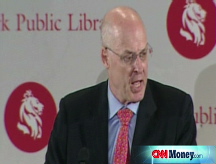Bonds fall as housing bill nears reality
Treasury prices dip as the government's plan to shore up the housing market gains momentum.
NEW YORK (CNNMoney.com) -- Treasury prices fell Wednesday as legislation aimed at rescuing the ailing housing market neared approval, giving bondholders a reason to venture back into more risky investments.
The benchmark 10-year note fell 7/32 to 97 30/32, and its yield rose to 4.13% from 4.10% late Tuesday. Bond prices and yields move in opposite directions.
The 2-year note declined 3/32 to 100 6/32 and yielded 2.76%. The 30-year long bond slid 16/32 to 94 30/32, with the yield rising to 4.69%.
President Bush dropped his opposition Wednesday to a housing bill, currently making its way through Congress, that would provide $300 billion in aid to troubled homeowners and lend support to mortgage financiers Fannie Mae (FNM, Fortune 500) and Freddie Mac (FRE, Fortune 500).
The bill is expected to pass the House later Wednesday afternoon but may go back to the Senate for a final vote.
"The rescue package is an overall positive for banks and brokers," said Bill Larkin, portfolio manager of Cabot Money Management in Boston.
The government's plan, coupled with a recent spate of better-than-expected quarterly results from financial firms, suggests that "the ultimate disaster in the banking sector is waning," Larkin said.
Fixed-income instruments like government-backed bonds are viewed by many investors as a safe haven during times of economic duress.
When the economy begins to show signs of strength, many investors sell bonds and seek out higher returns in riskier equity-based investments.
The bond market is also responding to signs that the Federal Reserve may raise interest rates when the central bank meets in September. On Tuesday, Philadelphia Federal Reserve President Charles Plosser said the Fed may need to hike rates "sooner rather than later" to fend off inflation. (Full story.)
"There is a fear that they will address the inflation problem sooner than people think," Larkin said.
Interest rate cuts are the central bank's main tool for spurring economic activity. But lower interest rates, which can lead to higher inflation, have become an increasing concern for policy makers.
Larkin said investors are now pricing in a 55% likelihood that the Fed will raise rates at its next meeting in September. ![]()



